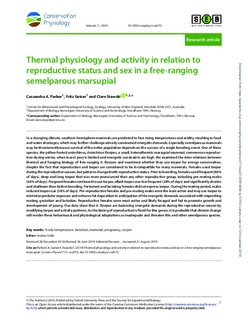| dc.description.abstract | In a changing climate, southern hemisphere mammals are predicted to face rising temperatures and aridity, resulting in food and water shortages, which may further challenge already constrained energetic demands. Especially semelparous mammals may be threatened because survival of the entire population depends on the success of a single breeding event. One of these species, the yellow-footed antechinus, Antechinus flavipes, a small, heterothermic marsupial mammal, commences reproduction during winter, when insect prey is limited and energetic constraints are high. We examined the inter-relations between thermal and foraging biology of free-ranging A. flavipes and examined whether they use torpor for energy conservation, despite the fact that reproduction and torpor are considered to be incompatible for many mammals. Females used torpor during the reproductive season, but patterns changed with reproductive status. Prior to breeding, females used frequent (86% of days), deep and long torpor that was more pronounced than any other reproductive group, including pre-mating males (64% of days). Pregnant females continued to use torpor, albeit torpor was less frequent (28% of days) and significantly shorter and shallower than before breeding. Parturient and lactating females did not express torpor. During the mating period, males reduced torpor use (24% of days). Pre-reproductive females and pre-mating males were the least active and may use torpor to minimize predator exposure and enhance fat deposition in anticipation of the energetic demands associated with impending mating, gestation and lactation. Reproductive females were most active and likely foraged and fed to promote growth and development of young. Our data show that A. flavipes are balancing energetic demands during the reproductive season by modifying torpor and activity patterns. As the timing of reproduction is fixed for this genus, it is probable that climate change will render these behavioural and physiological adaptations as inadequate and threaten this and other semelparous species. | nb_NO |

